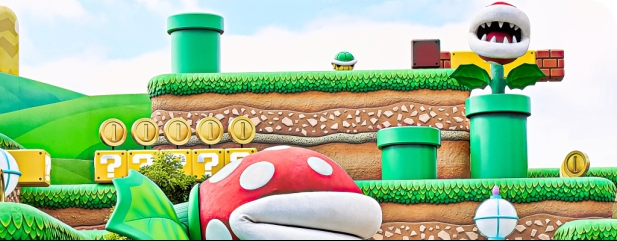Archived article
Please note that tax, investment, pension and ISA rules can change and the information and any views contained in this article may now be inaccurate.
How Nintendo is expanding its brand awareness to win over a new generation of gamers

One of the oldest video game characters is enjoying another resurgence as The Super Mario Brothers movie continues to pull-in punters. It is on course to be the largest grossing film of 2023, generating a billion dollars at the box office.
The loveable Italian tradesman Mario has featured in over 200 games since first appearing in 1981 as ‘Jumpman’ in the first Donkey Kong game. The character is the all-time bestselling video game franchise with over half a billion copies sold.
While 40 years may seem like a long time for a video game character, the company behind the game and character Nintendo (7974:TYO) goes back even further to the late 19th century when it sold playing cards.
Today Nintendo’s other successful franchises include The Legend of Zelda, Donkey Kong, and Pokémon.
A lasting connection with Nintendo
Nintendo provides some real-life case studies which demonstrate the longevity of its characters and how they have evolved to attract new audiences:
‘She played Super Mario Bros when she was six. Now she’s 42 and teaming up with her kids on Splatoon.’
‘Back when his was 24 he played Donkey Kong. Now he’s 60 and playing Nintendo Switch Sports with his grandchildren.’
WHAT DOES NINTENDO DO?
In a nutshell Nintendo is a vertically integrated gaming company (meaning it makes both the games and the devices to play them on), explains James Harries who holds the stock in investment trust Securities Trust of Scotland (STS) but its real value extends beyond gaming into ‘timeless, cross generational IP (intellectual property)’.
It is easy to get lost in the console wars debate which narrowly focuses on the gadgets used by gamers to access games, but the company is much more than a hardware or software company. Nintendo’s president Shuntaro Furukawa describes the company as an enabler of ‘unique entertainment experiences’ which integrates both hardware and software.
From a business perspective Nintendo says its fundamental strategy is to ‘expand the number of people who have access to Nintendo IP’. This captures the essence of the company’s culture.
Nintendo describes the uniqueness of its IP as follows: ‘We believe people gain affection for, and become invested in, the characters they encounter in games.
‘The way players connect with characters through their controller creates a two-way communication that is unique to video games. With our users’ support, this kind of IP has grown into something special.’
One of the key strengths of the business is its ability to adapt and innovate to ensure its characters appeal to new audiences less familiar with the characters. Having navigated rapid changes in the entertainment industry for over 100 years, the company has proven it can adapt and innovate while extending the life and attraction of its characters.
Another distinguishing feature of Nintendo’s customer base is the broad distribution of users by age which ranges from under five to over 60 with a peak around 21 years. Very few gaming products have such diverse cross generational appeal.
EXPANDING FRANCHISES
James Harries told Shares he believes Nintendo is a ‘unique asset’ which possesses long lasting IP, which attracts a wide family audience.
Family appeal is rare today among platform app providers and gaming companies which have come under fire for not policing age-inappropriate content.
While in the past Nintendo has been quite careful about how it monetises its IP, Harries said the company is being more open and expansive today as evidenced by theme parks (the first park outside Japan opened in 2023), merchandise, mobile applications, and visual content.
The main purpose of expanding outside of gaming is not necessarily to make a profit or diversify revenue but to drive awareness and potential gamers to its extremely profitable software and hardware businesses.
In other words, it’s all about strengthening and expanding points of contact with consumers. This is also an important differentiating point in relation to the debate over the battle of the consoles which is discussed later in the section on competition.
James Harries told Shares the reason he believes the shares trade on an attractive free cash flow yield of 10% to 11% is because the current Switch console is long in the tooth.
Nintendo is due to release a new device sometime in 2023 or 2024 which creates a risk that the new console is not as popular as the current one. Harries points out the company has had issues introducing newer but less popular upgrades in the past.
The Switch is the first hybrid console which means it can be used on the go as well as connected to a PC or TV.
HOW DOES NINTENDO MAKE MONEY?
Nintendo generates almost all its revenue from selling hardware (consoles) and software (games). Software sales include downloadable versions of packaged software, download only software, add-on content and Nintendo Switch online.
The company makes 76.4% of its sales outside of Japan which means the value of the Japanese yen against major currencies has a significant impact on the business. Nintendo hedges a small proportion of foreign exchange exposure.
Nintendo is very profitable which is reflected in high operating margins in the mid-30s percentage-wise (calculated as operating profit as a proportion of sales).
In the first nine months of 2023 to 31 December 2022 Nintendo achieved a gross margin of 53.9%. This represents the value-add of making games before deducting operational overheads.
Operating profit fell 13.2% to ¥410.5 billion ($3 billion) representing a margin on sales of 31.7%. Foreign exchange effects added around 10% to profit.
In November 2022 the company downgraded guidance for sales and operating profit in the 12 months to 31 March 2023 to ¥1,600 billion (£9.4 billion) and ¥480 billion (£2.8 billion) respectively. Ultimately the numbers came in slightly ahead of these reduced forecasts (9 May).
A good measure of the company’s progress against its goal of expanding the number of people with access to Nintendo’s IP is the number of annual users playing its games.
On this metric the company had 114 million players at the latest count which has grown roughly four-fold since 2018 according to company data.
NINTENDO HAS A DIFFERENT STRATEGY
Nintendo competes against deep pocketed rivals including Microsoft (MSFT:NASDAQ) which has a market capitalisation of £1.8 trillion, and Sony Corporation (SONY:NYSE), which has a market capitalisation of £91 billion, some 47 times and two times bigger respectively.
But Nintendo does not play the same game in terms of its business model. For example, and surprisingly Microsoft subsidises its Xbox which means it loses roughly $100 plus on every sale. Sony only recently broke even on hardware sales.
In contrast half of Nintendo’s 2022 profit came from hardware sales, the bulk of which were from its Switch console.
Nintendo’s consoles may not be as sophisticated, but they are cheaper to make. The company has a long history in consoles and developed the hugely successful Gameboy (1989) which is its third bestselling console selling 119 million units.
One of the reasons for Gameboy’s success was the popular game Tetris which has become Nintendo’s second bestselling video game franchise of all time, behind Mario.
Not only does Nintendo make a profit than from selling hardware, but it also generates a greater proportion of sales from its own games sold on the consoles (also called first party sales).
Over half of Nintendo’s Switch software sales come from its own games compared with under 10% for Microsoft and Sony. The Switch has 27 game titles which sell more than one million units.
Microsoft is moving towards owning its own platform, embracing cloud gaming and enabling non-Xbox gamers to play on phones, TV’s, and PC’s. In April Microsoft announced a 10-year partnership with gaming chip company Nvidia (NVDA:NASDAQ) taking Xbox games to the latter’s GeForce cloud gaming service.
Microsoft’s proposed $68.7 billion acquisition of Activision Blizzard (ACTV:NASDAQ) which has been stymied by the UK’s Competition and Markets Authority would leapfrog the tech giant above Nintendo into the third biggest gaming company.
How can I get exposure to Nintendo shares?
It is tricky to buy Nintendo shares directly but it is a top 10 holding in Lindsell Train Investment Trust (LTI), T Rowe Price Japanese Equity (BD446L1) and Vaneck Video Game and eSports ETF (ESPO).
Important information:
These articles are provided by Shares magazine which is published by AJ Bell Media, a part of AJ Bell. Shares is not written by AJ Bell.
Shares is provided for your general information and use and is not a personal recommendation to invest. It is not intended to be relied upon by you in making or not making any investment decisions. The investments referred to in these articles will not be suitable for all investors. If in doubt please seek appropriate independent financial advice.
Investors acting on the information in these articles do so at their own risk and AJ Bell Media and its staff do not accept liability for losses suffered by investors as a result of their investment decisions.
Issue contents
Editor's View
Feature
Great Ideas
News
- Travel stocks fly high as the sector finally enjoys a post-pandemic recovery
- US rate hikes fuel banking crisis and a surge in gold and bitcoin
- Heavy selling in Paramount on big streaming losses and a dividend cut
- Baltic Classifieds is motoring ahead with online sales growth
- Why consumer health spin-out Kenvue climbed in strong market debut

 magazine
magazine








